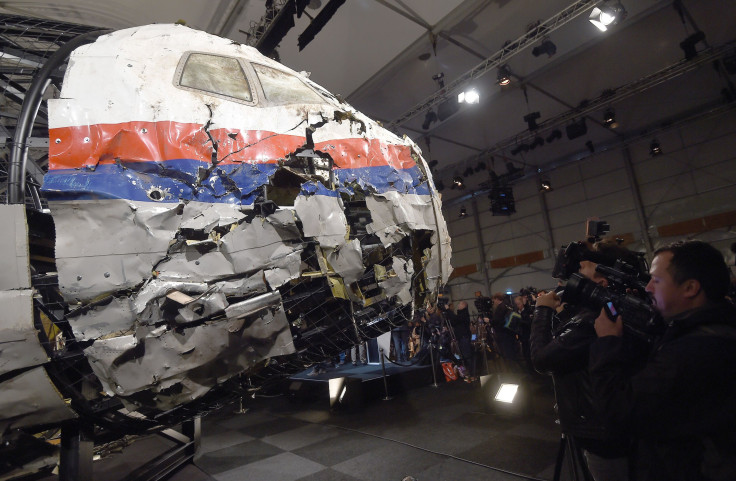Who Shot Down MH17? Russia's Air-To-Air Ukraine Missile Claim Debunked In New Report

The relatives of the 298 people killed on Malaysia Airlines flight MH17 on July 17, 2014, heard the long-awaited results of the Dutch Safety Board’s report Tuesday confirming what many experts had previously speculated: A missile fired from a Buk system brought down the passenger airliner. But the report stopped short of answering the politically charged question that Russia and Ukraine have been arguing over for months: Who shot down MH17?
“Other scenarios that could have led to the disintegration of the aeroplane were considered, analyzed and excluded based on the evidence available,” the report stated, rejecting Russian claims that a Ukrainian air-to-air missile brought down the plane.
Also absent from the report was the location from where the missile was fired, which could have pinpointed whether or not Ukrainian government forces or Russian-backed separatists controlled the territory. In addition, there was no answer on where the missile system originated.
“Of course, this doesn’t tell us who did it, who is accountable for it,” said Claudio Villanca-Vanetta, who lost his husband on MH17, according to the Guardian. “That is where we want to get now.”
Dutch Safety Board: Additional forensic investigation will be required to determine launch location, which is outside scope of the probe.
— Paul Sonne (@PaulSonne) October 13, 2015While the Dutch prosecutor’s office is set to release a report in early 2016 that will deal with the question of who shot down the plane, the White House issued a statement Tuesday calling the release of the Dutch report “an important milestone” and underscored that America's assessment was unchanged: MH17 was shot down by a missile fired from “separatist controlled territory in eastern Ukraine,” the release said.
This hasn’t stopped independent experts like Eliot Higgins from using open source information to trace the flow of weapons from Russia across the porous border into Ukraine. Higgins and his team released a report last year in which they claimed that the Buk system used to shoot down MH17 was part of convoy traveling from Kursk, Russia, to the Ukrainian border.
Western leaders have also cited other factors in pointing the finger at Russia. Separatist leader Igor Girkin, known by his nom de guerre Strelkov, bragged on social media July 17, 2014 about shooting down a Ukrainian military Antonov 26 plane. His posts were quickly deleted after it was discovered that a civilian plane had been shot down and not a military one.
Donetsk rebels say they don't have any comment at present, said they might have something to say later. #MH17 #report
— Ольга Ившина (@oivshina) October 13, 2015Shortly after the fatal MH17 incident, the Ukrainian government released an audio recording it said showed separatists discussing the downing of a plane. In the conversation, it becomes clear that the plane shot down was not a Ukrainian government military aircraft. One of the separatists says, “it was definitely a civilian aircraft.”
Ukraine’s Prime Minister Arseniy Yatsenyuk blamed Russian special forces for shooting down MH17.
“We are certain that this was conducted from territory that was only under the Russian fighters' control,” he said. “And there is also no doubt that drunk separatists do not know how to use these Buk systems. This means that these systems were operated only by trained Russian servicemen.”
The missile that took #MH17 down was launched from terrorist-controlled Snizhne — Vice PM Zubko
— The Bankova (@TheBankova) October 13, 2015Russia has continued to deny any direct military role in the conflict in Eastern Ukraine, and Russia’s Deputy Foreign Minister called the report an “obvious attempt to draw biased conclusions.”
On the same day as the Dutch report was released, arms manufacturer Almaz-Antey, which produces the Buk system, held a presentation in Moscow saying that Russia did not shoot down MH17. The manufacturer had claimed in June that a Ukrainian surface-to-air-missile fired from the town of Zaroschenskoe had brought down MH17.
BUK makers freely admit their aim here is rescuing their reputation and getting 'unjust' sanctions removed #MH17 pic.twitter.com/Z2crUbDx0h
— Sarah Rainsford (@sarahrainsford) October 13, 2015The war in Ukraine has taken the lives of over 8,000 people and displaced 1.4 million.
© Copyright IBTimes 2024. All rights reserved.






















